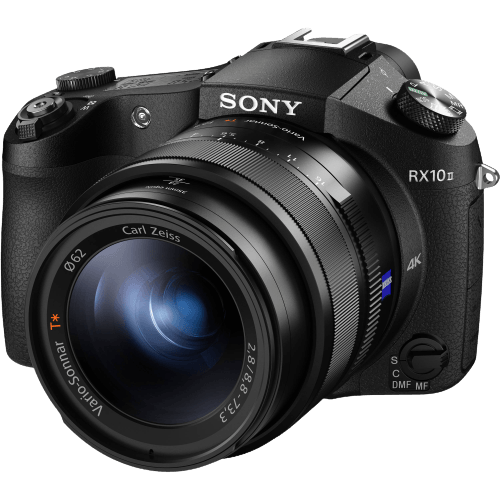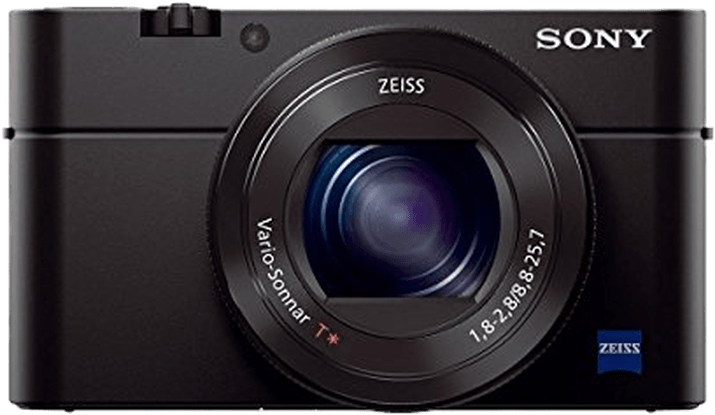Sony Cyber-shot DSC-RX10 II vs Cyber-shot RX100 IV Comparison
Sony Cyber-shot DSC-RX10 II

Sony Cyber-shot RX100 IV

The Sony Cyber-shot RX100 IV comes out on top with a score of 64/100, while the Sony Cyber-shot DSC-RX10 II trails behind with 59/100. Both cameras share the same announcement date of October 6, 2015, and release year of 2015. Their common specifications include a launch price of $950 for the RX100 IV and $1299 for the RX10 II.
The winning RX100 IV has a more compact size, measuring 102 x 58 x 41mm and weighing 298g, making it easier to carry around. On the other hand, the RX10 II has a larger size of 129 x 88 x 102mm and weighs 813g, which could be better suited for those who prefer a more substantial camera body.
In the end, the RX100 IV’s higher score reflects its better performance and more portable design, while the RX10 II may appeal to those who prioritize a larger camera body.
Sony Cyber-shot DSC-RX10 II vs Cyber-shot RX100 IV Overview and Optics
The Sony Cyber-shot RX100 IV wins in the optics department with a score of 66/100, compared to the Sony Cyber-shot DSC-RX10 II’s score of 64/100. Both cameras share several common specifications, such as 20-megapixel resolution, CMOS sensor type, Bionz X processor, 1″ sensor size, fixed lens mount, and image stabilization.
The RX100 IV outperforms the RX10 II in shooting speed, offering 16 frames per second (fps) compared to the RX10 II’s 14 fps. This advantage allows the RX100 IV to capture fast-moving subjects more effectively. Moreover, the RX100 IV has a higher DXOMARK sensor score of 82, indicating better overall image quality than the RX10 II’s score of 70.
On the other hand, the RX10 II has some strengths over the RX100 IV. Although it has a slightly lower optics score, the difference is minimal, and the camera still delivers high-quality images. Its shooting speed of 14 fps is still respectable, and in many situations, the difference in performance may not be noticeable.
To sum up, the Sony Cyber-shot RX100 IV takes the lead in optics, primarily due to its faster shooting speed and higher DXOMARK sensor score. While the RX10 II falls short in these aspects, it remains a solid contender with its own merits. However, if the fastest shooting speed and superior sensor performance are essential factors, the RX100 IV is the clear choice.
Sony Cyber-shot DSC-RX10 II vs Cyber-shot RX100 IV Video Performance
The Sony Cyber-shot DSC-RX10 II outperforms the Sony Cyber-shot RX100 IV in video capabilities with a score of 77/100, as opposed to the RX100 IV’s 69/100. Both cameras share some common specifications, including 4K maximum video resolution and 3840 x 2160 maximum video dimensions. Additionally, neither camera has built-in time-lapse functionality.
The RX10 II’s superior video performance can be attributed to its higher maximum video frame rate of 120fps, compared to the RX100 IV’s 60fps. This allows the RX10 II to capture smoother and more detailed footage, particularly in fast-paced situations or when recording slow-motion video.
While the RX100 IV has a lower video score, it still offers 4K video resolution and a respectable maximum video frame rate of 60fps. This makes it suitable for most casual video shooting scenarios, though it may not be ideal for capturing high-speed action or professional-quality slow-motion footage.
In comparing these two cameras, the Sony Cyber-shot DSC-RX10 II emerges as the better option for video enthusiasts, with its higher video score and maximum frame rate of 120fps. However, the Sony Cyber-shot RX100 IV remains a solid choice for those who prioritize compactness and portability, while still offering 4K video resolution and a decent frame rate of 60fps. Both cameras cater to different user needs, with the RX10 II being more suited for advanced videography and the RX100 IV for casual shooting with an emphasis on size and convenience.
Sony Cyber-shot DSC-RX10 II vs Cyber-shot RX100 IV Features and Benefits
The Sony Cyber-shot RX100 IV outperforms the Sony Cyber-shot DSC-RX10 II with a feature score of 70/100 compared to 57/100. Both cameras share several specifications, including a 3-inch screen size, 1228800-dot screen resolution, absence of GPS, and the presence of WIFI and Bluetooth capabilities.
The RX100 IV, the winning camera, has a touchscreen and a flip screen, which the DSC-RX10 II lacks. The touchscreen allows for quicker and more intuitive adjustments, while the flip screen enables shooting from various angles, making it more versatile in different situations.
On the other hand, the DSC-RX10 II, despite its lower score, may have some advantages over the RX100 IV depending on the user’s needs and preferences. However, this comparison focuses on the shared specifications mentioned earlier and does not delve into other aspects where the DSC-RX10 II might excel.
Taking into account the feature scores and the shared specifications, the Sony Cyber-shot RX100 IV is the better camera in terms of user experience and versatility, thanks to its touchscreen and flip screen capabilities. While the DSC-RX10 II may have its own merits, the RX100 IV is a more well-rounded option for those looking for a camera with a higher feature score and the added benefits of a touchscreen and flip screen.
Sony Cyber-shot DSC-RX10 II vs Cyber-shot RX100 IV Storage and Battery
The Sony Cyber-shot DSC-RX10 II outperforms the Sony Cyber-shot RX100 IV in storage and battery with a score of 24/100 compared to 16/100. Both cameras have one memory card slot and support SD, SDHC, SDXC, Memory Stick Duo, Pro Duo, and Pro-HG Duo cards. Neither camera offers USB charging.
The DSC-RX10 II has a longer battery life, providing 400 shots per charge, while the RX100 IV manages only 280 shots. The former uses an NP-FW50 battery, while the latter relies on an NP-BX1 battery. This difference in battery life makes the DSC-RX10 II a more reliable choice for extended shooting sessions.
However, the RX100 IV has UHS-I compatibility, which allows for faster data transfer rates when using compatible memory cards. This advantage may be beneficial for users who prioritize quick transfer speeds.
Considering the longer battery life, the Sony Cyber-shot DSC-RX10 II proves to be superior in terms of storage and battery performance. The RX100 IV’s UHS-I compatibility may be advantageous for some users, but overall, the DSC-RX10 II’s extended battery life makes it a more reliable option.
Sony Cyber-shot DSC-RX10 II vs Cyber-shot RX100 IV Alternatives
Still not sure which camera to buy? Try some more popular camera comparisons to inspire you:
